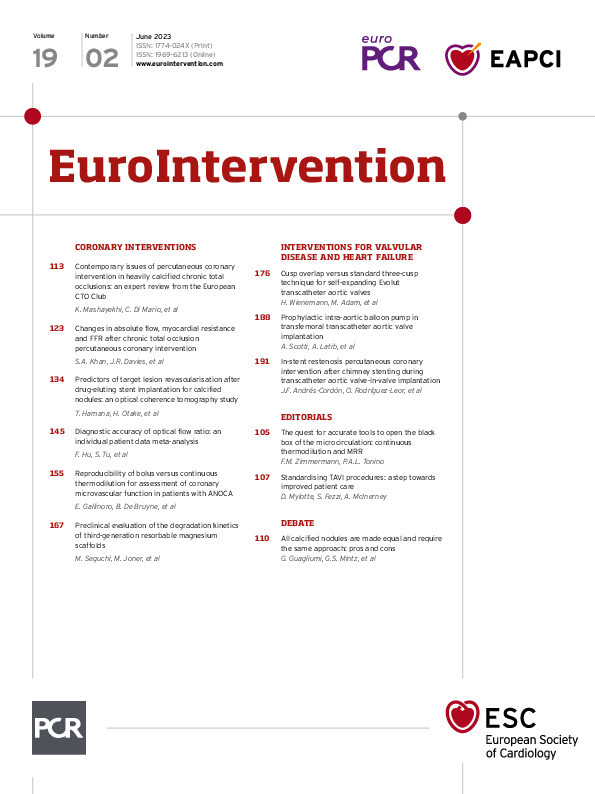A large proportion of patients with angina referred for coronary angiography do not have obstructive epicardial coronary arteries (ANOCA)1. In addition to epicardial coronary vasospasm, coronary microvascular dysfunction (CMD) might be the factor responsible for the impaired quality of life and morbidity in ANOCA patients. Therefore, in order to move forward, the clinical field is in need of a diagnostic metric with high accuracy and reproducibility for detecting and quantifying CMD. Such a metric could be used to reliably identify CMD in clinical practice, be of help in mechanistic explorations, and pave the way for testing potential therapeutic agents in clinical trials.
Several methods exist to invasively assess the microcirculation. Over the past decades, most CMD research has been based on bolus thermodilution and intracoronary Doppler measurements2. More recently, continuous thermodilution has been developed and validated to invasively quantify absolute coronary flow and microvascular resistance3. In addition, the microvascular resistance reserve (MRR) was developed to quantify the vasodilatory capacity of the microcirculation, independent of epicardial disease4. Since it can be challenging to obtain a reliable signal with intracoronary Doppler, thermodilution is the most commonly used method in current practice. Head-to-head comparisons on the reproducibility of both forms of thermodilution (bolus vs continuous) are lacking.
With this background, we read with great interest the study in this issue of EuroIntervention by Gallinoro and colleagues5. The investigators compared, head-to-head, the reproducibility of bolus versus continuous thermodilution in 102 patients with ANOCA. In all patients, an invasive assessment of microvascular function was performed using both bolus and continuous thermodilution, in duplicate. Patients were randomised in a 1:1 ratio to undergo bolus or continuous thermodilution first. The authors found that the variability of coronary flow reserve (CFR) using continuous thermodilution (CFRcont) was significantly lower (indicating higher reproducibility) than the variability of CFR measured with bolus thermodilution (CFRbolus) (12.8% vs 31.3%; p<0.001). Remarkably, the mean CFRcont was significantly lower than the mean CFRbolus (2.6 vs 3.3; p<0.001). The reproducibility of the continuous thermodilution-derived index MRR was higher than that of other bolus thermodilution-based indices, such as the index of microcirculatory resistance (IMR) and resistive reserve ratio (RRR). The most likely explanation for this significant difference in reproducibility is the operator dependence of bolus injections, resulting in differences in the administered bolus volumes and applied injection speed. In contrast, continuous thermodilution-based indices are operator independent: once the infusion pump has been started, the operator can “stand back and relax”.
One of the intriguing, unanswered questions is why CFRcont was significantly lower than CFRbolus (2.6 vs 3.3; p<0.001). Which of the two measurements represent the “true” CFR? Although the higher reproducibility found with continuous thermodilution does not necessarily indicate a higher accuracy, other evidence suggests that CFRcont may be closer to the true CFR value. First, a study comparing continuous thermodilution, using the gold standard [15O]H2O positron emission tomography (PET) during hyperaemia, found a strong correlation between both measurements6. Second, in line with the current study, previous studies suggested that CFRbolus slightly overestimates CFR versus [15O]H2O PET2. To solve the issue, a potential future study could compare CFR measured with both bolus and continuous thermodilution with CFR derived from [15O]H2O PET. A challenge for such a study is that a similar “resting state” is almost impossible to obtain when assessed at different moments and in different settings, such as in the catheterisation laboratory. Another interesting observation from the current study is that the current indices (CFR, IMR, MRR) do not explain the majority of “angina” with no obstructive coronary artery disease in this cohort. Additional testing, such as spasm provocation, may be needed.
In conclusion, the authors are to be congratulated for developing and validating a precise diagnostic tool for assessing the microcirculation. Continuous thermodilution provides superior reproducibility versus bolus thermodilution, mainly because of its operator independence. The MRR as assessed by continuous thermodilution provides a reproducible metric of the vasodilatory capacity of the microcirculation and is (in contrast to CFR) independent of epicardial disease. MRR is another step in the quest to open the black box of the microcirculation. We look forward to the results of ongoing studies on the prognostic value and therapeutic implications of continuous thermodilution and MRR.
Conflict of interest statement
P. Tonino has received research grants from Biosensors and OpSens. F. Zimmermann has no conflicts of interest to declare.

